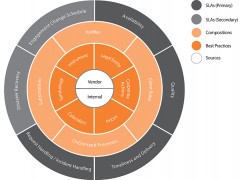Reference data management: utility is the future
So here is a major headache for the treasury and capital markets industry: the cost line remains dead flat but the revenue line has dropped off the cliff. Utility is the answer to the market woes, strongly believes Philippe Chambadal, CEO of SmartStream Technologies. He talks to Tanya Andreasyan about SmartStream’s initiative in this space.
As with most of the industry, the capital markets sector has been in considerable flux in the last few years, in terms of market drivers, new operational models and supplier consolidation. If there is a single buzzword then it is probably “utility” – which for those in the industry with long memories probably evokes a sense of déjà vu.
This time it is cost pressures that are meant to be the driver for such a shift and, certainly, several suppliers have been adjusting and componentising their offerings in the expectation that the current discussions will lead to actual decisions.
Rationalisation of systems, external and internal utilities, and better use of data are the flavour of the day. “There is a need to mutualise to remain profitable – and that means creating shared services for the industry,” states Chambadal.
SmartStream is not just talking the talk, but walks the walk: last year, the SmartStream Reference Data Utility (RDU) went in partnership with three top-tier banks: Goldman Sachs, JP Morgan Chase and Morgan Stanley.
The solution – known as Securities Product Reference Data (SPReD) – provides services for instrument reference data normalisation, enrichment and validation across all asset classes.
The three founding banks have also pledged to become clients of SPReD, which Chambadal feels is a ringing endorsement for the offering and a clear indication of the appetite for utility-type services.
Indeed, at the launch of the utility, Julie Harris, Goldman Sachs’ managing director in charge of operations data quality management, stated: “We believe this solution presents great value for our organisation and the broader industry”.
James Trait, managing director at JP Morgan Chase, described the utility as “a great example of how our industry can partner to improve effectiveness and reduce costs”.
His counterpart at Morgan Stanley, Eric Suss, managing director and head of institutional reference data, commented that “working together to ensure high-quality reference data is in everyone’s best interest”.
SPReD offers a multi-tenanted, auditable environment for data collection, cleansing, and change management based on customised integration standards to generate a flexible, bespoke golden copy.
The cost of repairing trade breaks is minimised and so is operational risk. The direct data management costs are reigned in too, whilst the service quality of reference data management is improved.
“Banks are running multiple applications, and in the case of large groups that have grown via mergers and acquisitions the software set-up consists of hundreds of systems,” Chambadal comments.
Furthermore, each bank and system have their own way of pulling data from the market, processing and presenting it – and the result is expensive and convoluted irregularities across the data value chain. Let alone trade breaks that come with hefty repair costs and reputation damage.
But can any financial institution today really justify a business case to reinvest in legacy technology and infrastructure, when – most likely – previous investments had not resolved common market issues present in their data?
And what is the point of trying to create the best data set in the world within your institution if you still have to interact and exchange it with the rest of the industry that is far from perfect, asks Chambadal. There are plenty examples of failed Golden Copy projects – when instead of focusing on successfully integrating the data that is timely and high quality, all its efforts were directed on getting data inside the firm, when most data issues reside between a firm and all their counterparties.
The utility offered by SmartStream delivers a data service “to realise the truth of the data contained within the industry with guaranteed results”…
This is an excerpt. The full article is available in the April 2016 edition of Banking Technology. Click here to read the magazine online.
To get your free printed copy, please register here.













































